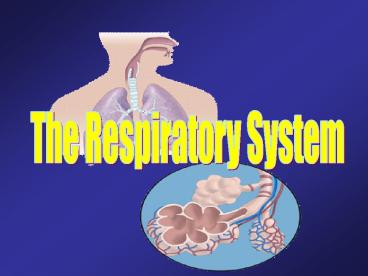The Respiratory System - PowerPoint PPT Presentation
1 / 21
Title:
The Respiratory System
Description:
Structure and Functions of the Repiratory system. Functions of the Respiratory ... Pulmonary venule (oxygenated blood) Respiratory. Zone. Alveolar sac. Alveoli: ... – PowerPoint PPT presentation
Number of Views:454
Avg rating:3.0/5.0
Title: The Respiratory System
1
The Respiratory System
2
Overview
Structure and Functions of the Respiratory system
Mechanisms of Breathing
Oxygen Transport
Repiratory Dynamics
Respiratory Disease
The Respiratory System
3
Structure and Functions of the Repiratory system
Functions of the Respiratory System
3. Regulate blood pH
The Respiratory System
4
Structure of the Repiratory system
The Respiratory system consists of two main
divisions or zones
1. Respiratory Zone
2. Conductive Zone
The Respiratory System
5
Structure of the Repiratory system
Conductive Zone
All of the structures that convey air from
outside of the body through to the lungs
The Respiratory System
6
Lobes and Structures of the Lungs
Pleural Structures
7
Structure of the Repiratory system
Respiratory Zone
All of the structures involved with the exchange
of gases between inspired air and the blood
http//www.mhhe.com/biosci/genbio/animation_quizze
s/graphics/abm3s1g.ram
The Respiratory System
8
The Bronchial Tree
9
Mechanisms of Breathing
Pulmonary ventilation -
the process of movement of air from the
environment to the lungs (and back)
This process can be separated into inspiration
and expiration, and depends on a difference in
pressure created between the lungs and the
environment (Bulk flow).
GAS EXCHANGE O2 diffuses into the alveoli to be
exchanged at the capillaries
The Respiratory System
10
Mechanisms of Breathing
Expiration
GAS EXCHANGE CO2 diffuses into the alveoli to
be exhaled
Quiet breathing (passive)
- Muscles lining the alveolar sacs recoil, the
diaphragm relaxes and air is pushed out of the
lungs
Forced breathing (active) during vigorous
exercise
- Internal intercostals move ribs inferiorly and
internally - The diaphragm relaxes, moving superiorly creating
intrathoracic pressure that is large relative to
the environment, resulting in air rushing out of
the lungs
http//www.mhhe.com/biosci/genbio/animation_quizze
s/graphics/abm3s3a.ram
The Respiratory System
11
Mechanisms of Breathing
?V, ? P
Volume and Pressure are inversely related!
? ?Vol. ? ? Press
Fluids (air) flow from high to low pressure.
Inspiration (within lungs)
? Vol. ? ? Press
? V, ? P
Expiration (within lungs)
? Vol. ? ? Press
http//www.mhhe.com/biosci/genbio/animation_quizze
s/graphics/abm3s3h.ram
The Respiratory System
12
Muscles of Breathing
The Respiratory System
13
Pulmonary Ventilation
Tidal volume (VT) air exchange each breath
Frequency of breathing (f) of breaths per
minute
Pulmonary ventilation (VE) -
the volume of air moved by the lungs each minute
The Respiratory System
14
Pulmonary Ventilation
Not all inspired air takes part in gas exchange,
some air remains in the conductive zone (e.g.
trachea, bronchi, etc)
Dead space ventilation (VD) -
inspired air that does not reach the respiratory
zone
Alveolar ventilation (VA) -
inspired air that reaches the respiratory zone
- Basal region (bottom) receives more ventilation
than apex (top) at rest
- During exercise, apex receives increased of
ventilation
The Respiratory System
15
Pulmonary Ventilation
Spirometry measurement of inspired/expired
volumes of gas
The Respiratory System
16
External/Internal/Cellular Respiration
External respiration exchange of O2 and CO2 in
lungs
Internal respiration exchange of O2 and CO2 in
body tissues
Cellular respiration cells use O2 to generate
energy in mitochondria
External
Cellular
The Respiratory System
17
Alveoli - Site of External Respiration
Terminal Bronchiole
1. _________________
Pulmonary artery
2. _________________
Smooth muscle
3. _________________
Respiratory bronchioles
4. _____________________
Alveolar sacs
5. _________________
Capillary beds
6. _________________
Pulmonary vein
7. _________________
The Respiratory System
18
- Gas Exchange
External Respiration
Partial pressure (PO2/PCO2) fraction of
pressure exerted by a gas when part of a mixture
Diffusion movement of molecules from an area of
high to low concentration (pressure)
Ficks Law rate of diffusion is
- proportional to tissue area
- proportional to pressure gradient (difference)
- Inversely proportional to thickness of tissue
Henrys Law amt. of gas diffusing/dissolving
into a liquid is proportional to the partial
pressure and the solubility of the gas
The Respiratory System
19
- Gas Exchange
External Respiration
Note Gas exchange is most efficient when the
ratio of blood flow to the lungs is
equal to the ventilation (L/min).
Observe the pressure gradients (PO2,PCO2) in
the following diagram between alveolar gas/blood
and tissue/blood.
105 mm Hg
http//www.mhhe.com/biosci/genbio/animation_quizze
s/graphics/abm3s5b.ram
The Respiratory System
20
Control of Pulmonary Ventilation
The respiratory control centre lies within the
brain stem. Specifically, the medulla oblongata
(Waterboy) and the pons.
Two specialized centres, inspiratory and
expiratory, in the medulla oblongata send signals
to the various respiratory muscles to control
breathing.
Inspiratory centre
- generates rhythmical signal that stimulates the
diaphragm and the external intercostals to
contract (freq. 12 15 breaths/min rest)
Expiratory centre
- ensures inspiratory muscles never completely relax
- stimulate forceful expiration during exercise
The Respiratory System
21
Control of Pulmonary Ventilation
Two specialized centres found in the pons are the
pneumotaxic and apneustic centres.
These two centres ensure that transitions between
inhalation and exhalation are smooth.
These are not the only areas of the brain
influencing ventilation.
- Areas that control skeletal muscle also stimulate
the breathing centres
- Sensory systems provide feedback information on
chemical and pH levels in the blood
The Respiratory System






























